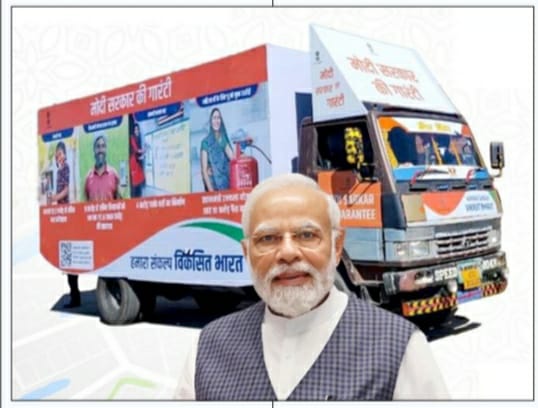It is a universal trend among governments to launch schemes of varied nature to explore the economic potential available in various sectors to improve the living standard of their citizens. In fact, every government has its own vision of customizing these welfare schemes.
After independence, we have witnessed innumerable schemes launched by successive governments for the welfare of citizens. However, most of the schemes launched with big fanfare used to lose steam as most of the targetted audience usually remained outside the ambit of such schemes. The main drawback was not in the design of the schemes, but the mass awareness element was almost missing in such endeavors. Scant attention was given to mass awareness programmes about these government welfare schemes. Owing to this lack of knowledge among the general public, most of these schemes failed to achieve the desired economic goals. Interestingly, the departments and organizations would own the scheme but used to shrug-off the responsibility of running its awareness/education programmes with a single liner – the operative levels are advised to ensure due publicity of the scheme.
However, in the last nine years of the National Democratic Alliance (NDA) government, led by Narendra Modi, we witnessed (and continue to witness) a changed scenario. The government has been customizing the schemes for varied segments of societies and communities on a continuous basis. It is not framing of schemes alone, in fact, the government launched these welfare schemes embedded with a complete mass communication model, where feedback in the context of these schemes has been emphasized. Needless to mention that in a communication process, the feedback is received only when the message is communicated. Here the message is awareness of the schemes and the feedback is the response of the beneficiaries.
Precisely, it is for the first time that the central government has gone beyond the customary launching of the schemes and is running vast awareness/education programmes under the banner of Viksit Bharat Sankalp Yatra (VBSY). This speaks about the seriousness of the government to see its citizens achieving economic prosperity and resultantly contribute to the economic growth of the country.
Viksit Bharat Campaign
The Viksit Bharat Sankalp Yatra, precisely called Viksit Bharat campaign, was launched on November 15, 2023, to spread awareness about the government of India (GOI) flagship schemes tailored over a period of one decade for various segments of population, particularly those in the country’s rural geography. It is perhaps going to be the world’s largest awareness/education campaign. Since its launch, the campaign has been dominating prominent space in varied media channels, be it print or electronic, where experts and other stakeholders are calculating its impact on the beneficiaries and overall economy of the country.
However, in this whirlpool of analysis and opinions, let us deliberate upon the Viksit Bharat campaign in the context of financial schemes tailored by the central government and routed through the banking system. If the PM Jan Dhan Yojana (PMJDY), launched in August 2014, emerged as the world’s largest ever financial inclusion programme, the mass financial awareness and education programme under the banner of Viksit Bharat Sankalp Yatra (VBSY) initiative is going to be shot in the arm of strengthening the much required financial literacy/education among the Indian societies and communities.
PMJDY Success Story
We have observed that financial inclusion was always a major concern for the governments at the centre. It was only after customizing a universal financial scheme, PM Jan Dhan Yojana, in 2014 that witnessed crores of first-time bank account holders across the country coming into the fold of the formal financial system through banking channels. Government data reveals that PMJDY accounts have grown three-fold (3.4) from 14.72 crore in March 15 to 50.09 crore as on 16-08-2023. Total deposit balances under PMJDY accounts stand at Rs. 2,03,505 crore.
This remarkable growth vets the grand success of the scheme as the world’s largest Financial Inclusion Programme. A lot of innovation at the back of advanced technology has taken place in the scheme at regular intervals and today, almost 34 crore RuPay cards stand issued to the PMJDY account holders. Remarkably, with such huge number of RuPay debit cards, as per the government data, installation of 79.61 lakh PoS/mPoS machines and the introduction of mobile based payment systems like UPI, the digital transactions have gone up from 1,471 crore in FY 17-18 to 11,394 crore in FY 22-23. The total number of UPI financial transactions have increased from 92 crore in FY 2017-18 to 8,371 crore in FY 2022-23. Similarly, total number of RuPay card transactions at PoS & e-commerce have increased from 67 crore in FY 2017-18 to 126 crore in FY 2022-23.
However, getting the unreached into the fold of the formal banking system alone is not enough. There has always been a dire need to make the people aware and educate them about the features and benefits of financial schemes. In fact, the integration of advanced technology into the financial schemes has made awareness programmes of paramount importance. Otherwise also, even the most literate persons have been found struggling in understanding financial matters that too when digital transactions have become order of the day.
Notably, financial inclusion and financial literacy/education are twin pillars. Financial awareness/education will stimulate the demand side – making people aware of what they can and should demand, while financial inclusion acts from the supply side – providing in the financial market what people demand. However, financial awareness/education needs to be developed hand in hand with improving access to financial services.
Opportunity for banks
So, in the given scenario, Viksit Bharat Sankalp Yatra (VBSY) is a huge platform for banks to launch customized financial awareness/education programmes and achieve their financial and other targets in a most sustainable manner. In marketing parlance, the banks would be able to sell these government schemes in a most prudent way and help themselves to achieve their annual targets envisaged under their annual credit plans. At the end, getting prudent borrowers under the ambit of these government backed schemes will ensure twin objectives for the banks. One, it will add to their brand value as a responsible corporate citizen with a breed of loyal customers. Two, it will add more colour to their business with growth and profitability.
Remarkably, the VB campaign simultaneously provides a huge opportunity to banks to pitch their other schemes and services alongside the government welfare schemes. A knowledgeable customer base is all in the interest of banks’ operational efficiency and every penny spent on financial awareness of societies/communities would be investment, not expenditure.



